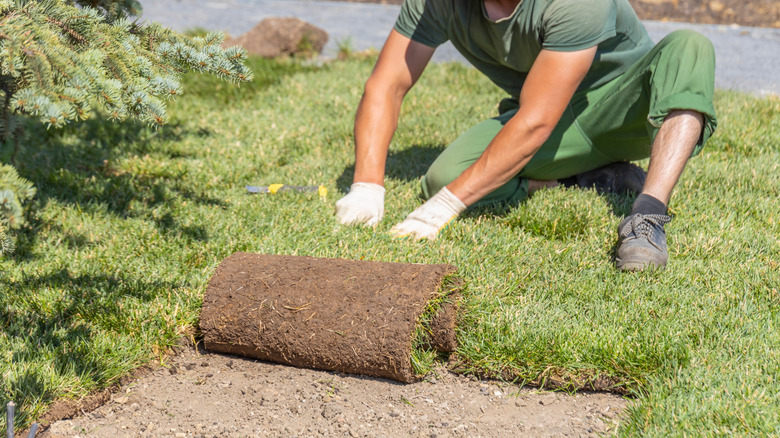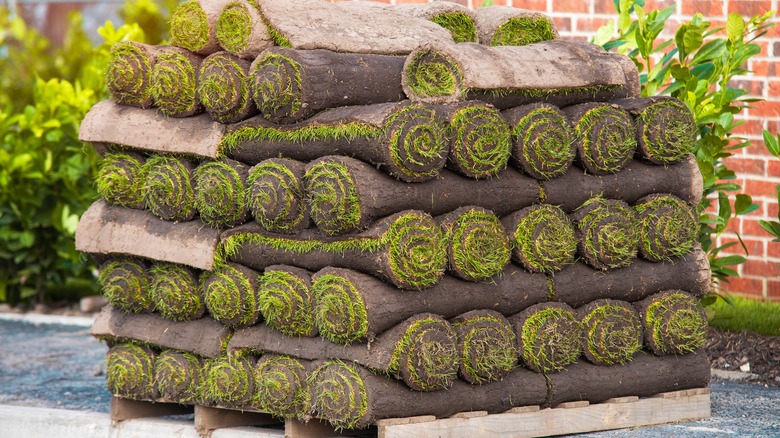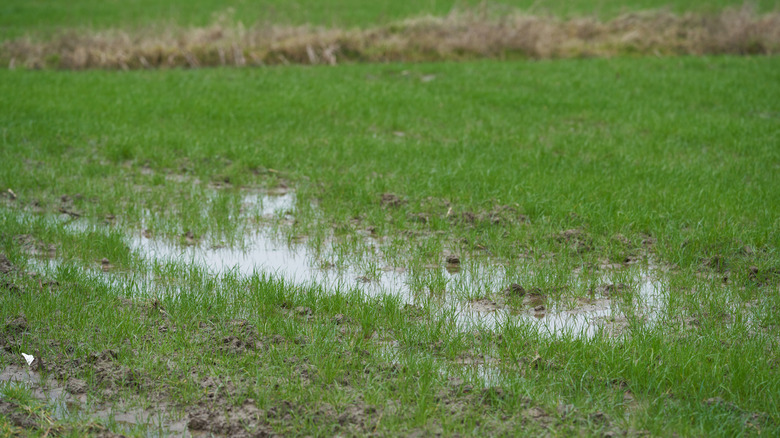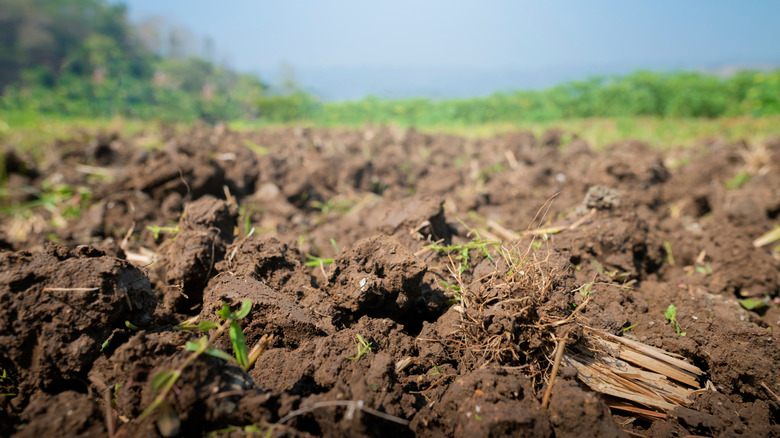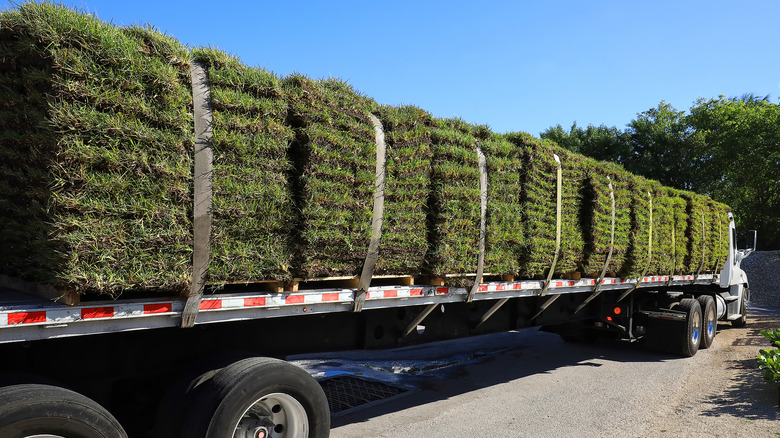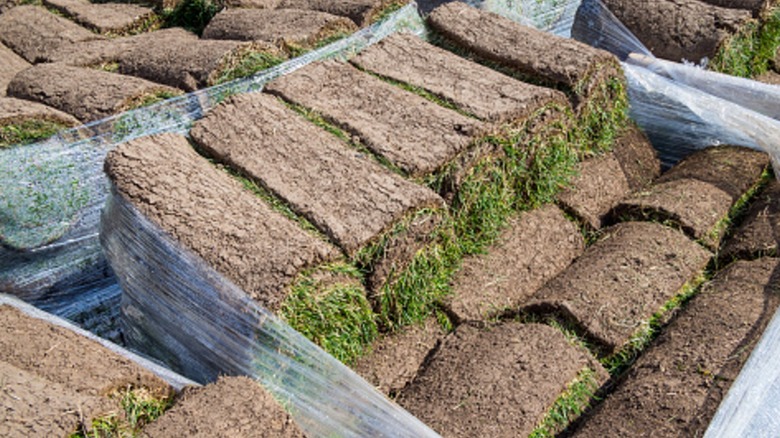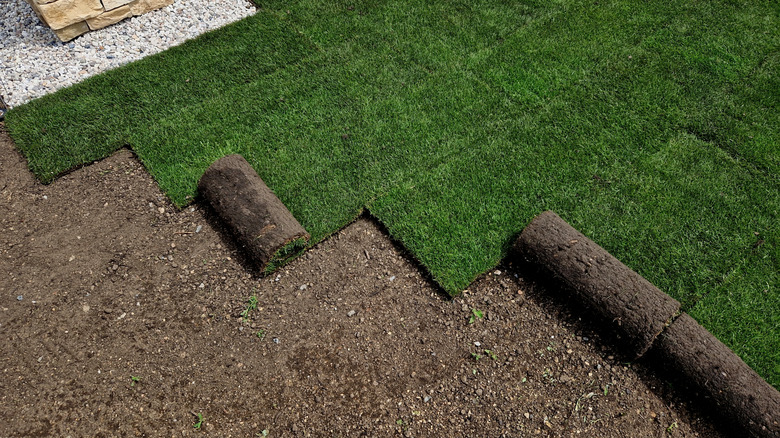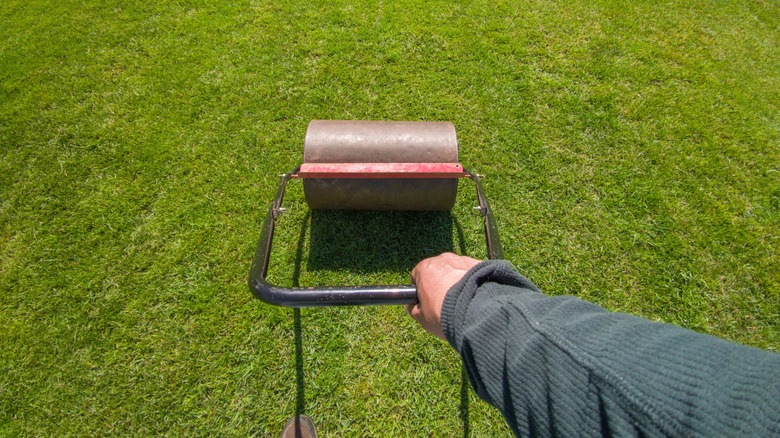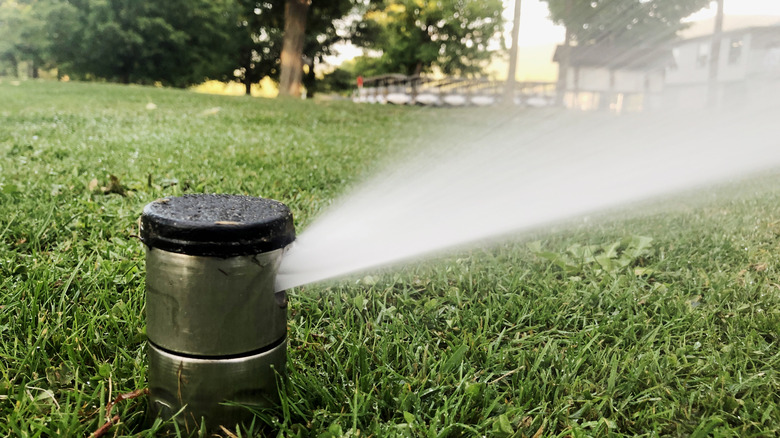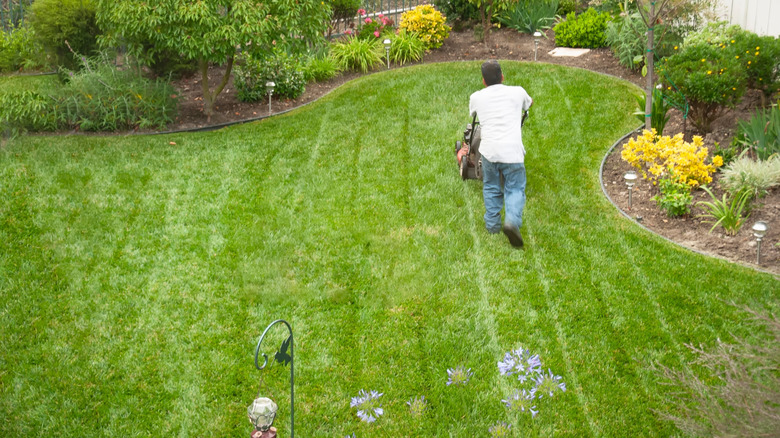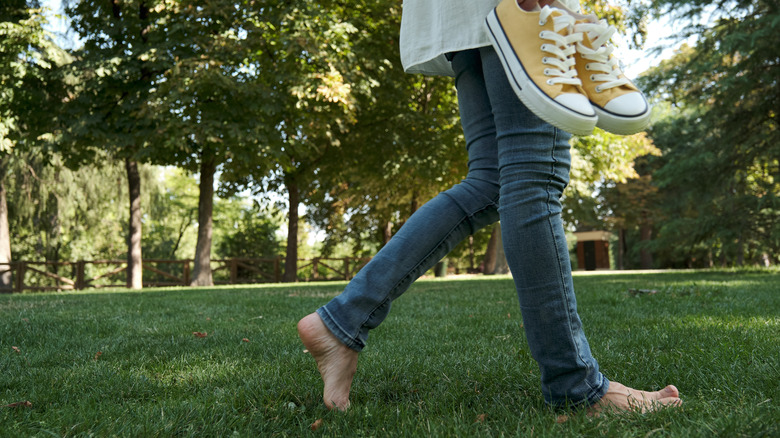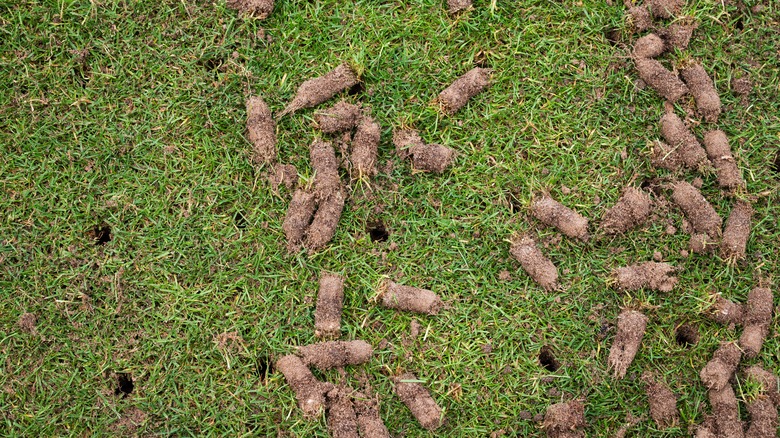Sod Installation Mistakes Everyone Makes & How To Avoid Them
We may receive a commission on purchases made from links.
If you've decided to invest in sod for your yard, you want to do everything you can to help it take root and thrive. The last thing you want is for the new turf to turn yellow or brown, or even to completely die. This would mean that all of that money you spent was for nothing — and purchasing new grass for a yard is not exactly a cheap undertaking. Unfortunately, getting sod to grow properly and stay healthy can be a challenge. Many people make mistakes when installing it, and these errors can have serious consequences. They can leave you with an unattractive yard, increase your workload when you're laying the new turf, or even result in the death of some or all of the sod you purchased.
To help you avoid these catastrophic errors, we've compiled a list of some of the most common mistakes to avoid. In addition to telling you what you should steer clear of, we'll also share what you should do to install sod properly to ensure that it takes root, receives all the water it needs, and is set up for success over the coming days, weeks, months, and years.
Ordering too little or too much sod
Picture this: You've been working hard to install the new sod you ordered for your yard. You've got most of the area covered, but there's still a large patch of bare dirt. The only problem is there's no more sod left, so now you'll have an eyesore on your otherwise pristine new lawn. You'll have to place an order to have more delivered — for an added cost — and dedicate more time to installing it when it arrives. Failing to properly calculate how much new turf you'll need is a mistake you certainly want to avoid. Just as you don't want to come up short, you also don't want to be left with several more rolls than you need — that's just wasting your money.
To avoid either of these problems, you must accurately calculate the amount of sod that is needed for your job. To do this, you must determine the area of your lawn. Depending on the layout of your lawn, you may find it easier to calculate the total square footage by breaking it into smaller sections, finding the area of each of these shapes, and adding everything together. Remember, the area of a square or rectangle is found by multiplying the length by the width. However, to find the area of a triangle-shaped section, you'll need to multiply the length of the base by the height, and then divide that number by 2.
Failing to check the soil's pH and nutrient levels
Skipping the step of testing your soil is a mistake that can leave you in the dark regarding the best ways to care for your lawn. Soil tests give you insight into the pH and nutrient levels of the dirt, and without that information, you'll just have to make random guesses when it comes to choosing the right fertilizer for your sod. Beyond that, you're also missing the perfect opportunity to make changes to the dirt before you install the new turf so that it can take root and thrive. Wouldn't now be the easiest time to address any deficiencies when it is so easy to access the soil?
Instead, take the opportunity to conduct testing before ordering new grass. Luckily, it's relatively easy to complete. Be sure to follow the specific directions from the soil test you purchase, such as the Whitetail Institute Laboratory Soil Test Kit, but most require you to take several samples from a specific depth. These samples are then sent to a lab where they're analyzed, and you should then receive a report.
Use the information in the report to help you determine the needs of your soil. For example, if the pH is too high (alkaline), you'll want to lower it with some elemental sulfur, such as Earth Science's Fast Acting Sulfur. If phosphorus or potassium levels are too low, you can look for an appropriate fertilizer to increase them, such as Hi-Yield Triple Super Phosphate 0-45-0 Granules or Sulfate of Potash, respectively. Soil tests also provide information about how much organic matter is present in the dirt. If your test reveals that your soil has less than 2 or 3% organic matter, then it would be a good idea to amend it with some peat moss or compost to help ensure that essential nutrients reach the new turf.
Neglecting to grade the surface to prevent future erosion issues
Another mistake you could make before you even touch the new sod strips is failing to adjust the grade of your yard, if necessary. An overly sloped yard can mean big trouble. If water is rushing down a huge hill, it can cause erosion. The topsoil and even your freshly laid sod may be washed away. Beyond the threat to your newly installed turf, a steep grade can result in a flood at the base of the slope. You don't want a huge pool of water in your yard, do you?
You should consider having your yard graded before installing sod. If the slope drops more than about 1 foot for every 4 feet of distance, you may face erosion or water pooling problems. While there are many yard maintenance tasks homeowners can tackle on their own, regrading is one that is best left to the experts. Depending on the scope of the project, special equipment may be needed. If you attempt a DIY, you also risk accidentally hitting a water or electric line, and causing further issues. Professionals know what they're doing and will be able to help you achieve a better grade to give your sod the best chance at success, while also decreasing other potential water-related issues.
Trying to lay sod over existing grass or weeds
The last thing you want to notice is signs your sod isn't taking root. But, if you make the mistake of trying to lay it over existing grass or weeds, that is precisely what could happen. If you don't kill — and thoroughly remove — any weeds that are present, they're going to remain beneath the surface. Soon, they'll crop up and begin invading the grass. Laying sod over existing turf also isn't a good idea. In order for the roots to establish themselves and strengthen, they must come into direct contact with the soil. Anything — including patches of grass — between the sod and soil will interfere with this process and may leave you with an unhealthy or dying lawn.
Instead, you must be very careful to thoroughly clear your yard of any weeds and grass before moving forward with the installation. A non-selective herbicide can help you achieve this goal, such as Compare-N-Save Glyphosate Concentrate Grass & Weed Killer Herbicide, as it'll kill any plants it comes into contact with. Keep in mind, however, that you'll want to start well before you plan to install your new turf. To effectively rid the area of all weeds and grass, multiple applications will likely be necessary. You should also wait several days after the final application to make sure that you don't see any new weeds or grass pop up. Lastly, be sure to wear proper protection when using chemical herbicides.
Weeds and grass aren't the only things that can get in the way of the new sod being able to root deeply. Other objects, such as trash, rocks, or sticks, could also be problematic. So, after you've finished getting rid of weeds and grass, be sure to walk the yard and remove anything that could form a barrier between the roots and the dirt.
Failing to oversee the delivery
When you order sod, it will be delivered on pallets. Many companies may offer to leave it on your property, even if you're not home. However, allowing them to deliver at a time when you aren't present will be a mistake that can cost you a lot of added time and effort. If all the pallets of sod are left in a single location, then that means that you'll have to move many rolls a great distance before being able to lay them.
Instead, if you're home when the sod is delivered, you can direct the crew to position the pallets where they'll be most convenient. Spreading them out across the yard will prevent you from having to carry any of the heavy rolls too far. This will not only reduce the total time you'll need for the installation, but it will also save you from overexerting yourself. Another reason to be around when the new turf is delivered is to inspect it. Take the time to confirm that the quantity matches what you ordered and make sure that you received the correct species.
Waiting too long to install the sod once it is delivered
If you wait too long to install the sod, you're making a mistake. The longer you wait, the more time the freshly cut grass will have to dry out. Moreover, the turf is delivered in rolls. These rolls are compacted and will be letting off heat. As you can probably imagine, excessive amounts of heat are not good for the new grass. The longer you leave everything rolled up, the weaker it will become. If left too long, it could even die.
Ideally, you should install the new sod on the same day that it is delivered. This will require some planning ahead, especially if you need to line up help from a friend or family member. As soon as you place the order, confirm the expected delivery date and get your plans in motion. In some cases, it may be possible to wait a day or two to install it. However, if you are going to wait at all, lightly watering the rolls may be necessary. When spraying with the hose, focus on the edges of each roll, since these will dry more quickly than other sections.
Not laying the sod strips properly
Knowing how to properly lay the strips of your new turf is essential. If mistakes are made, it can lead to a variety of problems. First, that new, lush and manicured lawn that you're seeking could end up looking sloppy and uneven. Cracks could also develop between the strips, making the seams glaringly obvious. Beyond the aesthetics, improperly laid sod may also not properly take root, leaving you with dying grass in no time.
So, how should you lay the strips? To start, you should edge any walkways or driveways that are in the yard to ensure the pieces are flush and neat against their sides. You'll need a sharp knife to cut away pieces of sod to match the curves and lines of the walkways. Then, to fill in the rest of the yard, you'll want to avoid lining the pieces up so that all of the ends are in a straight line. Think about the staggered pattern that is used with bricks or subway tiles and aim to mimic that. You should also take care to avoid the mistake of overlapping the strips as you lay the sod. Instead, make sure the edges are flush against one another.
Skipping the step of rolling the lawn
Once you've finished laying the sod on the soil, you're still not done for the day. Walking away and skipping the step of rolling the new turf will be a mistake. Without rolling, there may be sections of sod that are not fully flush with the soil beneath them. Any gaps or openings can prevent the roots from contacting the soil and deeply establishing themselves, which could cause the new turf to become unhealthy or, possibly, even die.
Rolling your lawn isn't too complex, but it does require a special tool: a grass roller. Fortunately, you should be able to rent one from a local landscaping or home improvement store. However, if you want to own one, you can get a model like the 13 gallon Outvita Lawn Roller for $62. While there are different versions of rollers, they offer a similar cylindrical design that you can either manually push over a lawn or pull across it using a tractor. Most models are designed to be filled with water or sand, allowing you to customize the weight to avoid overly compacting the dirt beneath your new lawn.
Under- or over-watering it
Improperly watering your new lawn is a recipe for disaster. Too much water can interfere with the roots' ability to take hold. If they're getting lots of water from the hose or sprinkler, they won't feel the need to search for more in the soil. Thus, the grass won't get deeply established, leaving it open to lots of issues. Excessive water can also cause root rot in your new turf. If this happens, the root will be overly soft and brown — something that certainly isn't going to promote healthy growth. While over-watering isn't good, under-watering can also be detrimental. If the sod is allowed to dry out, it won't be able to root properly. This can cause the grass to turn yellow or brown, and will increase the chances of death.
So, just how much should you water new sod? It will depend on just how new it is. For the first few weeks, aim to apply at least an inch of water in the morning (before 10:00 a.m., at which point temperatures will rise and cause too much evaporation). An in-ground system will ensure the best success, but you can also water using a sprinkler. Once those initial two weeks of very consistent, heavy, early morning watering have passed, you can cut back on how much hydration you're providing. However, it is still crucial to make sure that the sod doesn't dry out, so aim to water once every two to three days, depending on weather conditions.
Not knowing the best time and way to mow the new lawn
Many people make mistakes when it comes to mowing their new lawns. Cutting the grass too early or with an improper method could cause irreparable harm. If you push a mower over the sod before it has had a chance to root, you'll be more likely to tear or damage it. The younger roots are also much thinner early on, so you could inadvertently harm them as well.
Instead, it is crucial to wait to mow until the tuft has started to take root. It is typically safe to mow new sod after about two weeks. However, you should still gently attempt to lift a corner of the sod to confirm that the roots are connected to the soil before proceeding. You should also make sure that your mower is set up properly. Choose the highest blade setting to avoid cutting the new grass too close to the root, which you could inadvertently damage. A riding mower is too heavy for new turf, so be sure to use a push model for the first several weeks.
Letting people, or pets, walk on your new lawn right away
Your sod is finally installed and the yard is looking amazing, so now is the perfect time to have the neighbors over to show it off, right? Well, this could prove to be a mistake if you let them walk on the lawn. Letting anyone walk over your sod too soon will threaten its ability to properly take root and to remain healthy. These new roots are very thin, so it doesn't take much to damage them, potentially cutting off the supply of water and key nutrients to parts of your new lawn.
As a general rule, avoid walking on the sod as much as possible for at least the first two weeks, though three to four weeks would be even better. Then, over the following few weeks, you may allow light traffic over the new lawn, but still be cognizant to avoid doing something excessively rough that may accidentally damage it.
Keep in mind that these rules apply not only to people, but to pets, too. In fact, you should strive to keep pets off the new lawn for two months. Plus, your dog's urine can be to blame for the grass turning yellow due to its high levels of acidity and salt content. Protect your new and vulnerable grass from this threat.
Overlooking the benefits of aerification
While aerification — also called aeration — may not be 100% mandatory when installing new sod, it has benefits that you shouldn't overlook. Soil can get very tightly compacted and this can make it difficult for the roots of the sod to push down deep. With such conditions, the new lawn won't get all of the water and nutrients from the soil that it could with more ideal conditions. Additionally, it can help tackle any issues related to the merging of your existing soil and the soil the sod was grown on.
Fortunately, aeration exists to help with this. It is the process of essentially hole-punching the lawn to add pockets of air to reduce how tightly compacted the soil is. To aerate your soil, you can rent an aerifier, which is a large tool with spinning tines that you push across the lawn to make the small holes. You can also buy a handheld one for around $30, such as the EEIEER Lawn Coring Aerator Tool, but this would only be best for small lawns. Just wait a minimum of six months to a year to give the new turf time to get rooted.
